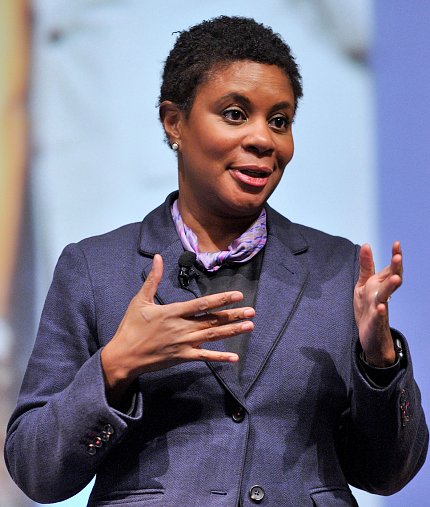‘Social Life’ of DNA Has Unique Power

Photo: Marleen Van Den Neste
The rise of genetic testing over the past 20 years, especially with respect to genealogy, has revealed DNA’s social power in addition to its biological power, said Dr. Alondra Nelson at a Jan. 17 Wednesday Afternoon Lecture in Masur Auditorium.
“Genetic analysis, including genetic ancestry testing, is popping up in new social domains almost every day,” said Nelson, president of the Social Science Research Council and professor of sociology at Columbia University.
In the early 2000s, companies started to offer direct-to-consumer genetic/genealogy testing. Nelson said that among the early adopters of genetic testing were educated African-American senior citizen women. At first, she wondered why this community was interested in pioneering these new technologies even though they had historical reasons to be wary of science.
She found that genetic testing gave them the opportunity to learn where their ancestors came from. Genetic data, Nelson said, “is the ultimate big data.” It can be used in medicine and forensic science in addition to genealogy.
The first research papers using genetic analysis answered long-standing questions about slavery and race in the United States, Nelson explained. One article, for example, used genetic analysis to claim that Thomas Jefferson fathered the children of Sally Hemings, one of his slaves.
Genetic analysis has also revealed clues to the history of buried slaves. In 1991, the General Services Administration began constructing an office building in lower Manhattan. Soon after work began, the remains of more than 300 men, women and children were discovered. Eventually, it was determined the site was a burial ground for slaves.
“What started as a construction site became an [anthropological] excavation,” she said.
A forensic anthropology team at a local college began to exhume the remains. Activists calling themselves Descendants of the African Burial Ground were concerned that the approach the college was using to examine the remains “would reduce their ancestors’ social identity to skin color.”

Photo: Marleen Van Den Neste
As a result of their concerns, the remains were sent to a laboratory at Howard University. Nelson said the lab conducted a rigorous historical, archeological and biological examination of each body to provide a detailed account of each person buried there.
Most African Americans know little about their ancestors who were sold into slavery. A company called African Ancestry infers individuals’ African heritage using DNA testing. Those who use the service receive their results along with a “certificate of ancestry” detailing their African roots.
African Americans who receive inferences about where their ancestors may have come from may use that information to connect with the past, Nelson said.
Descendants of an ethnic group from Sierra Leone invited Nelson to a ceremony of remembrance called a “sara” on the banks of a river outside Charleston, S.C. Saras are held every 7 years after the death of someone to remember his or her soul. The ceremony was held on the site of at least two slave auctions.
Attendees told Nelson their results from African Ancestry had allowed them to feel that they could participate in this ceremony of remembrance. The ceremony “gives a lot of psychic and religious satisfaction to those who participate,” she added.
Others have used genetic data to strengthen their legal argument for reparations for slavery. In 2002, activist Deadria Farmer-Paellmann organized a class action lawsuit by descendants of slaves. The lawsuit was dismissed because “the plaintiffs could not establish a personal injury by merely alleging some genealogical relationship to African Americans held in slavery” hundreds of years ago.
Farmer-Paellmann then purchased African Ancestry DNA testing kits for the plaintiffs. She submitted the results of the tests in response to the dismissal. However, the court again rejected the lawsuit because “genetic mapping or DNA testing is alone insufficient to proving decisively a link to a homeland.”
Nelson said the case was one of the first instances “in which an upper-level court has had to deal with commercial and cultural output of the human genome project.”
Some seek to use DNA to unite people of African heritage with Africa. Leon Sullivan, a civil rights activist who focused on creating jobs for African Americans, organized summits beginning in 1991 to bring together African leaders to work on projects related to economic development. By 2008, the summit began encouraging the development and use of DNA testing “to identify specific linkages to African ethnic groups among members of the African diaspora to enable and inform choices about national affiliation.”
Genetic ancestry data has given communities the ability to find information they wouldn’t be able to find otherwise, Nelson concluded. The testing “sits in the center of some of our endeavors to use genetics to advance issues of health equality and move forward with scientific research.”
